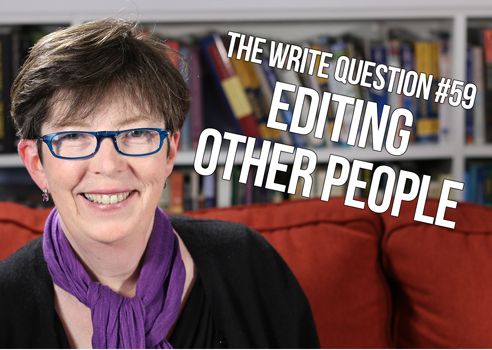Viewing time: 3 min. 58 sec.
The Write Question is a weekly video podcast about writing that I started in 2017 and that ran, more or less weekly, until April 2022. This is a republication of issue #59, with advice about how to be a better editor. The post first ran on June 22/18.
Transcript:
Welcome to The Write Question, I’m Daphne Gray-Grant. Today I’m giving advice on how to better edit other people’s writing.
I have a question from Frank Light who is based in Paris, France. Here’s what he asked:
“What is the best way to review material with a writer one-on-one? The last time I sat with an editor was when I worked at a weekly years ago. She had my printed feature draft in hand, with edits in red ink. I’m assuming the tools used today would be MS Word track changes. However, I wanted to understand the mechanics from a professional.”
Thanks for the question, Frank. I’ve been an editor for more than 40 years now but I can remember what it was like to be edited myself. As a result, I always approach the job with a great deal of care and concern.
I don’t think many of the key principles with respect to editing others have changed in the last 40 years, except perhaps that the work has become digital. But here’s how I approach the task:
I don’t think it’s my job to impose my style on the writer. Instead, I think I have a responsibility to help the writer express their own style in the best possible way. Also, I understand that people learn more when they fix things themselves. As a result of these two philosophical choices, I try not to dive into stories — even problematic ones — and start rewriting them holus-bolus.
Instead, I have the habit of pointing out problems and I challenge the writer to fix them. If the beginning of an article is too boring, I might suggest, “Can you start with a story or anecdote instead?” Or if the article is lacking transitions, I might suggest one transition and ask the writer to use even more. (Below, I’m including a link to a blog post I’ve written on transitions.)
I take this approach even with grammatical problems. If someone has inflicted an unclear antecedent on the reader, then I simply mark it “unclear antecedent” and leave it up to the writer to fix the problem. (If you don’t know what an ‘unclean antecedent’ is, check the link in the description below.)
This can be more time consuming, but the benefit is it helps protect my ongoing relationship with the writer. They don’t see me as desperate to put my voice in their stories. They know I want to help them become better. Most writers would prefer to fix their own problems rather than have someone else sweep in and take charge.
To answer your other question, yes, the best way of editing today is to use “track changes” in MS Word or in Google docs. But here’s one other specific tip to keep in mind. Never use red ink. Many people have been terrorized by high school teachers and have a negative visceral reaction to red. For that reason, I always use purple or blue.
As an editor, your most important job is to help your writers improve over time. This is far more crucial than the excellence of any given story. You want your writers to become more skillful and more confident. You don’t achieve this end by ignoring problems, of course. But if you simply rewrite every story to your own taste, the writer won’t learn to improve.
Finally, let me wrap up with a quote from English writer H.G. Wells. “No passion in the world is equal for the passion to alter someone else’s draft.”
Frank, if you can teach yourself to become a coach and a mentor to your writers, you’ll be doing them a huge favour and you’ll get much better work from them in the end.
Links:
Why writers need to build bridges (transitions)


